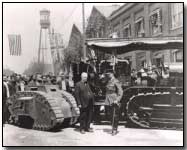Who's Who - Sir Ernest Swinton
 Sir Ernest Dunlop Swinton (1868-1951)
was one of the driving forces behind the creation and adoption of the
tank by
the British during the First World War.
Sir Ernest Dunlop Swinton (1868-1951)
was one of the driving forces behind the creation and adoption of the
tank by
the British during the First World War.
Born in Bangalore, India in 1868, Swinton was commissioned into the Corps of Royal Engineers in 1888. Between 1889-94 he served in India, receiving a commission as Lieutenant in 1891.
Having served in Second Boer War (1899-1902), during which time he received the DSO medal, Swinton served in varied capacities prior to the outbreak of war in August 1914: as staff officer, in teaching positions, and as an official British historian of the Russo-Japanese War. When war broke out in 1914 Swinton had reached the rank of Lieutenant Colonel.
Lord Kitchener, the War Minister, appointed Swinton the official British war correspondent on the Western Front; journalists were strictly barred from the battlefield. Swinton's necessarily anodyne accounts of the conduct of the war were personally vetted (and censored) by Kitchener prior to release to the press.
His reporting may have been bland but Swinton was alarmed at what he saw on the Western Front, how the infantry were cut down in swathes by machine gunnery. He therefore set his fertile mind to the task of determining how the war might be better fought in trench conditions.
During Christmas 1914 he chanced to see a Holt's tractor towing a gun - which gave him the inspiration for the tank. He quickly wrote a memo suggesting the development of what became known as the tank and sent it (despite lack of interest from the then-Commander in Chief Sir John French and his advisers) to Maurice Hankey, Secretary of the War Council in London.
Hankey, who was himself intrigued by Swinton's idea, passed the note to the First Lord of the Admiralty, Winston Churchill. Churchill soon envisaged the potential benefits of such a weapon and, with Lloyd George's support, established the Landships Committee to design and manufacture a test model.
Churchill's involvement, as naval minister, was not so outlandish as first appeared. Already the navy had deployed squadrons of armoured cars to protect naval airstrips in Belgium; the tank appeared a logical extension of the armoured car.
Once the prototype tank had been successfully demonstrated to Churchill and Lloyd George (among others) the latter authorised immediate production of the weapon to begin. Too late for the start of the Somme Offensive, its battlefield debut came at Flers in September 1916. It became a battlefield staple for the remainder of the war and beyond.
Having embarked on a lecture tour of the U.S. in 1918, Swinton retired in 1919 having been made an honorary Major General. He served as Controller of the Information Department of Civil Aviation at the Air Ministry from 1919-21. He became a director the Citroen company in 1922 (until 1951) and was created KBE in 1923.
Thereafter re-entering academia Swinton became Professor of Military History at Oxford University from 1925-39. He was Colonel Commandant of the Royal Tank Corps from 1934-38.
Swinton published his autobiography in 1951, having earlier published Eyewitness (his byline when working for the army), recounting his wartime experiences. He died in 1951.
Click here to read one of Swinton's wartime 'Eye Witness' accounts, encompassing fighting on the Aisne in September 1914. Click here to read his account of events during the First Battle of Ypres on 11-12 November 1914.
"Lance corporal bacon" was the name used by Anzac soldiers to describe very fatty bacon with a sliver of lean meat running through it.
- Did you know?
